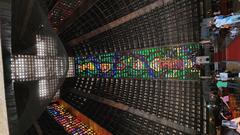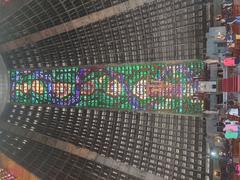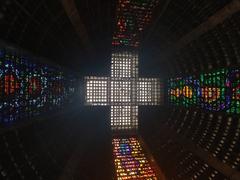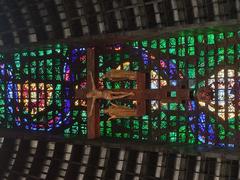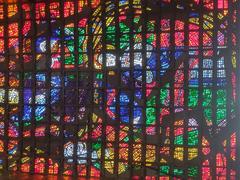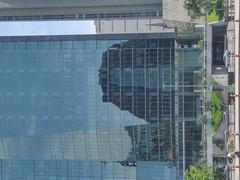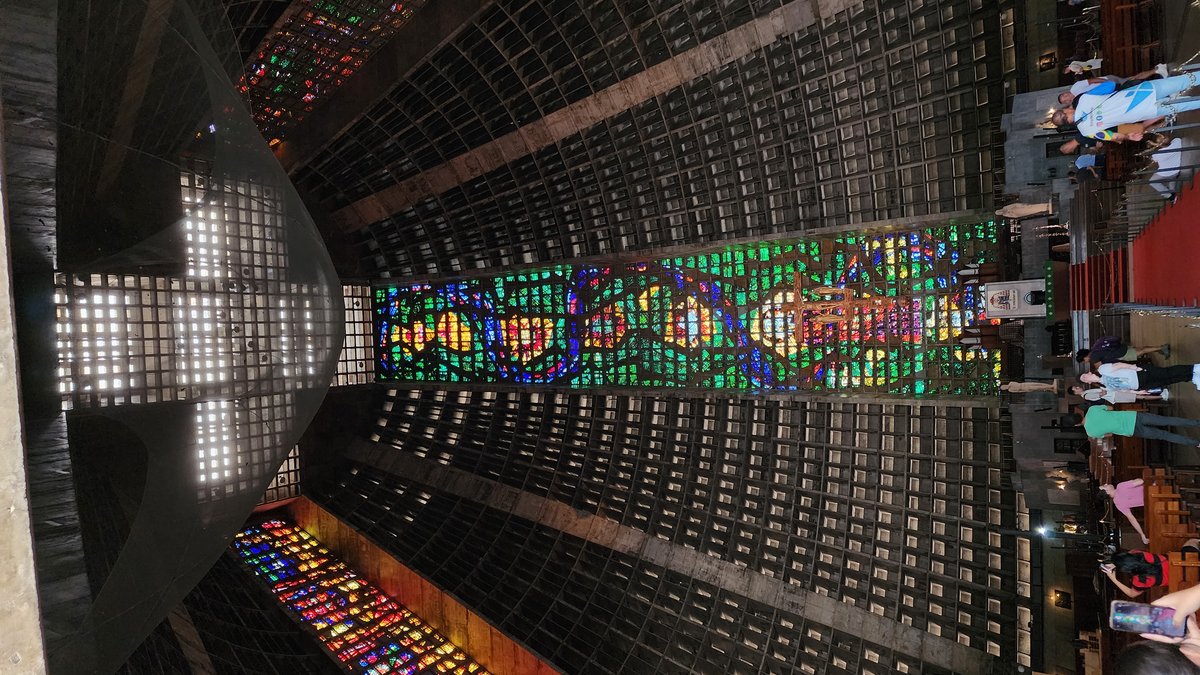
Rio de Janeiro Cathedral: Visiting Hours, Tickets, and Travel Guide
Date: 14/06/2025
Introduction
The Metropolitan Cathedral of Saint Sebastian (Catedral Metropolitana de São Sebastião do Rio de Janeiro) is a defining landmark in Rio de Janeiro, renowned for its avant-garde architecture, profound religious significance, and central role in the city’s cultural and civic life. Located in the heart of downtown Rio, the cathedral draws visitors with its soaring conical design, massive stained glass windows, and vibrant spiritual community. This detailed guide covers the cathedral’s history, architecture, visiting hours, ticket information, accessibility, safety, travel tips, and nearby attractions—everything you need for a memorable visit to one of Rio de Janeiro’s most iconic historical sites (Pilgrim Info; riomemorias.com.br).
Contents
- Historical Background
- Origins and Evolution
- Conception and Construction
- Papal Visits and Milestones
- Architectural Highlights
- Design Inspiration and Symbolism
- Monumental Scale and Features
- Stained Glass and Sacred Art
- Visiting Information
- Location and Getting There
- Visiting Hours and Tickets
- Accessibility and Facilities
- Safety and Travel Tips
- Experience and Photo Opportunities
- Nearby Attractions
- FAQ
- Conclusion
- Sources
Historical Background
Origins and Evolution
The Catholic presence in Rio de Janeiro dates back to the late 17th century with the establishment of the Diocese of São Sebastião in 1676 by Pope Innocent XI (Pilgrim Info). The original cathedral, a modest adobe structure on Morro do Castelo, was replaced over time by several churches, reflecting the city’s expanding religious and urban landscape. The Church of Our Lady of Mount Carmel (now the “Old Cathedral”) served as the city’s spiritual center from the late 18th century, but by the 20th century, a larger, more modern facility was needed (Art Facts).
Conception and Construction
In the early 1960s, plans for a new cathedral materialized under the guidance of Cardinal Jaime de Barros Câmara. Architect Edgar de Oliveira da Fonseca designed the current structure, inspired by Mayan pyramids and the principles of Vatican II. Construction began in 1964 and concluded with the cathedral’s consecration in 1979. The dedication to Saint Sebastian, the city’s patron, marked the tricentenary of the archdiocese (riomemorias.com.br).
Papal Visits and Milestones
The cathedral’s national and international significance was cemented by visits from Pope John Paul II in 1980 and 1997, as well as Pope Francis in 2013. These events drew massive crowds and underscored the cathedral’s role as the heart of Catholicism in Rio (Pilgrim Info; rioculturalsecrets.com).
Architectural Highlights
Design Inspiration and Symbolism
Fonseca’s design breaks from traditional Gothic and Baroque forms, opting instead for a bold, conical structure inspired by Mayan pyramids of the Yucatán (kasadoo.com). The circular layout ensures all worshippers are equidistant from the altar, symbolizing unity and equality before God. The design reflects the modern liturgical emphasis on inclusivity and simplicity following Vatican II reforms (riomemorias.com.br).
Monumental Scale and Features
- Height: 75 meters (246 feet) at the exterior apex
- Diameter: 106 meters (347 feet) outside; 96 meters (315 feet) inside
- Capacity: 5,000 seated, up to 20,000 standing (Atlas Obscura)
- Materials: Concrete exterior with honeycomb patterns and thousands of small windows
- Doors: Main entrance features 48 bronze reliefs illustrating the Creed of the People of God; side doors symbolize hope and charity (riomemorias.com.br)
Stained Glass and Sacred Art
Four monumental stained glass windows, each 64 meters high, align with the cardinal points and represent the four marks of the Catholic Church: One (green), Holy (red), Catholic (blue), Apostolic (yellow). Their vivid colors illuminate the entire interior, especially under the central skylight, which forms a giant Greek cross (rioculturalsecrets.com).
The suspended crucifix above the altar, designed by Benedictine monk Paulo Lachenmayer, and statues of Saint Sebastian and Saint Anne further enrich the liturgical environment. The crypt and basement museum house significant religious artifacts, including Emperor Dom Pedro II’s throne and a rare Golden Rose from Pope Leo XIII (Imaginario de Janeiro).
Visiting Information
Location and Getting There
- Address: Avenida Chile, 245, Centro, Rio de Janeiro (Trip.com)
- Metro: Carioca and Cinelândia stations (Lines 1 and 2) offer easy access; from Carioca, follow signs to Av. Almirante Barroso and use the pedestrian overpass (Tour by Transit)
- Bus/Taxi: Public buses and official taxis or ride-hailing apps are widely available
Visiting Hours and Tickets
- Opening Hours: Typically open daily from 7:00 AM to 5:00 PM; some sources report 6:00 AM to 6:00 PM. Hours may vary on holidays or for special events (eligasht.co.uk; Imaginario de Janeiro)
- Admission: Free entry; donations are appreciated. Some guided tours or special museum exhibits may charge a fee (freewalkertours.com)
Accessibility and Facilities
- Wheelchair Access: Ramps and elevators ensure access to the main areas; the museum in the basement may have limited accessibility
- Restrooms: Available for visitors
- Gift Shop: Sells religious items and souvenirs
- Assistance: Staff available during opening hours; English and Portuguese spoken
Safety and Travel Tips
- General Safety: The Centro district is safe by day but less secure at night; avoid deserted areas after dark (Travellers Worldwide)
- Personal Security: Keep valuables secure, avoid flashy jewelry, use anti-theft bags, and be discreet with electronics
- Transportation: Use official taxis, ride-hailing apps, or public transport; avoid unlicensed taxis (Travellers Worldwide)
- Health: Use insect repellent, stay hydrated, and protect yourself from the sun
- Dress Code: Modest attire required; cover shoulders and knees, remove hats inside (eligasht.co.uk)
- Photography: Allowed without flash; be mindful during services
Experience and Photo Opportunities
- Stained Glass Windows: Visit in the morning or early afternoon when sunlight illuminates the interior
- Interior Shots: Wide-angle photos from the nave capture the conical ceiling and crucifix
- Exterior Views: Best from Praça da Cruz Vermelha
- Museum of Sacred Art: Open Wednesdays and weekends; offers artifacts from Brazil’s royal and religious history
Nearby Attractions
The cathedral’s central location makes it an ideal hub for exploring Rio’s historical and cultural highlights:
- Escadaria Selarón: 10-minute walk to the famous tiled staircase (PlanetWare)
- Biblioteca Nacional: One of the world’s largest libraries in a neoclassical building
- Museu Nacional de Belas Artes: Brazilian and international art collections
- Theatro Municipal: Ornate opera house inspired by Paris Opera
- Arcos da Lapa: Iconic aqueduct and nightlife hotspot
- Nossa Senhora do Carmo (Old Cathedral): Former royal chapel
- Copacabana and Ipanema Beaches: 20–30 minutes by metro or taxi (Genuine WBE)
- Christ the Redeemer: Accessible by train or taxi
- Sugarloaf Mountain: Famous for panoramic city views
- Tijuca National Park: World’s largest urban rainforest
Frequently Asked Questions (FAQ)
Q: What are the Rio de Janeiro Cathedral visiting hours?
A: Typically 7:00 AM–5:00 PM daily; check for holiday variations.
Q: Is there an entrance fee?
A: No, entry is free for all visitors.
Q: Are guided tours available?
A: Yes, through local providers and occasionally at the cathedral; check schedules in advance.
Q: Is the cathedral accessible for people with disabilities?
A: The main areas are accessible; some sections like the basement museum may have limited access.
Q: How do I get there by public transit?
A: Use Carioca or Cinelândia metro stations, or city buses. Taxis and ride-hailing apps are also convenient.
Q: What should I wear?
A: Modest clothing—cover shoulders and knees; no hats inside.
Q: Is it safe to visit the cathedral?
A: Yes, during the day; take standard precautions and avoid the area late at night.
Conclusion
The Metropolitan Cathedral of Saint Sebastian stands at the crossroads of Rio’s spiritual, cultural, and architectural life. Whether you are drawn by its monumental stained glass, its innovative design, or its role in Brazilian religious history, the cathedral promises a powerful and memorable experience. Its central location makes it the perfect starting point for exploring Rio’s many historical treasures. For the best experience, visit during daylight hours, dress appropriately, and consider joining a guided tour for deeper insights.
For more travel inspiration, real-time updates, and curated itineraries for Rio’s top attractions, download the Audiala app and follow us on social media.
Sources
- Pilgrim Info
- riomemorias.com.br
- eligasht.co.uk
- Imaginario de Janeiro
- Art Facts
- Rio Cultural Secrets
- Atlas Obscura
- Discover Walks
- The Collector
- kasadoo.com
- Trip.com
- Tour by Transit
- Travellers Worldwide
- PlanetWare
- Genuine WBE
- freewalkertours.com
